一、本文介绍
本文给大家带来的改进机制是由由我本人利用HAT注意力机制(超分辨率注意力机制)结合V8检测头去掉其中的部分内容形成一种全新的超分辨率检测头。混合注意力变换器(HAT)的设计理念是通过融合通道注意力和自注意力机制来提升单图像超分辨率重建的性能。通道注意力关注于识别哪些通道更重要,而自注意力则关注于图像内部各个位置之间的关系。HAT利用这两种注意力机制,有效地整合了全局的像素信息。本文中均有添加方法和原理解析,本文内容为我独家创新。
欢迎大家订阅我的专栏一起学习YOLO!

专栏目录:YOLOv8改进有效系列目录 | 包含卷积、主干、检测头、注意力机制、Neck上百种创新机制
专栏回顾:YOLOv8改进系列专栏——本专栏持续复习各种顶会内容——科研必备
目录
一、本文介绍
二、基本原理介绍
三、核心代码
四、HATHead的添加方法
4.1 修改一
4.2 修改二
4.3 修改三
4.4 修改四
4.5 修改五
4.6 修改六
4.7 修改七
4.8 修改八
4.9 修改九
4.9 修改十
五、 目标检测的yaml文件
5.1 yaml文件
5.2 运行记录
六、本文总结
二、基本原理介绍

官方论文地址: 官方论文地址点击此处即可跳转
官方代码地址: 官方代码地址点击此处即可跳转


这张图片展示了两种神经网络模块的结构:自注意力模块(Self-Attention Module)和卷积模块(Convolution Module)。这两个模块被设计用于搜索最佳组合,以在保持记忆效率的同时实现特征提取。
自注意力模块包含以下部分:
- 一个1x1的卷积层,用于降低特征维度(c1->c2),减少自注意力的计算负荷。
- 多头自注意力层(MHSA),能够捕获特征间的长距离依赖关系。
- 另一个1x1的卷积层,用于恢复特征维度(c2->c1)。
- 批量归一化层(BN),用于网络训练中的规范化处理。
- 加法操作,将自注意力模块的输出与初始输入相加,形成残差连接。
- ReLu激活函数。
卷积模块包含以下部分:
- 一个降采样步骤,通过0.5倍的降频和3x3的卷积来降低空间分辨率,减少计算量。
- 一个1x1的卷积层,用于特征转换。
- 一个上采样步骤,通过2倍的增频恢复空间分辨率。
- 批量归一化层(BN)。
- 加法操作,将上采样后的输出与降采样之前的输入相加,实现跳跃连接。
- ReLu激活函数。
总结:
图中所示的模块是为了在高分辨率特征提取中寻找高效的结构。自注意力模块旨在捕获更广泛的上下文信息,而卷积模块则专注于保留局部信息和减少计算复杂度。这两种模块的结合旨在通过架构搜索找到一个既能高效提取特征又能保持较低计算成本的最佳网络结构。
三、核心代码
核心代码的使用方式看章节四!
import math
import torch
import torch.nn as nn
from basicsr.archs.arch_util import to_2tuple, trunc_normal_
from einops import rearrange
from ultralytics.utils.tal import dist2bbox, make_anchors
__all__ = ['HATHead']
def drop_path(x, drop_prob: float = 0., training: bool = False):
"""Drop paths (Stochastic Depth) per sample (when applied in main path of residual blocks).
From: https://github.com/rwightman/pytorch-image-models/blob/master/timm/models/layers/drop.py
"""
if drop_prob == 0. or not training:
return x
keep_prob = 1 - drop_prob
shape = (x.shape[0],) + (1,) * (x.ndim - 1) # work with diff dim tensors, not just 2D ConvNets
random_tensor = keep_prob + torch.rand(shape, dtype=x.dtype, device=x.device)
random_tensor.floor_() # binarize
output = x.div(keep_prob) * random_tensor
return output
class DropPath(nn.Module):
"""Drop paths (Stochastic Depth) per sample (when applied in main path of residual blocks).
From: https://github.com/rwightman/pytorch-image-models/blob/master/timm/models/layers/drop.py
"""
def __init__(self, drop_prob=None):
super(DropPath, self).__init__()
self.drop_prob = drop_prob
def forward(self, x):
return drop_path(x, self.drop_prob, self.training)
class ChannelAttention(nn.Module):
"""Channel attention used in RCAN.
Args:
num_feat (int): Channel number of intermediate features.
squeeze_factor (int): Channel squeeze factor. Default: 16.
"""
def __init__(self, num_feat, squeeze_factor=16):
super(ChannelAttention, self).__init__()
self.attention = nn.Sequential(
nn.AdaptiveAvgPool2d(1),
nn.Conv2d(num_feat, num_feat // squeeze_factor, 1, padding=0),
nn.ReLU(inplace=True),
nn.Conv2d(num_feat // squeeze_factor, num_feat, 1, padding=0),
nn.Sigmoid())
def forward(self, x):
y = self.attention(x)
return x * y
class CAB(nn.Module):
def __init__(self, num_feat, compress_ratio=3, squeeze_factor=30):
super(CAB, self).__init__()
self.cab = nn.Sequential(
nn.Conv2d(num_feat, num_feat // compress_ratio, 3, 1, 1),
nn.GELU(),
nn.Conv2d(num_feat // compress_ratio, num_feat, 3, 1, 1),
ChannelAttention(num_feat, squeeze_factor)
)
def forward(self, x):
return self.cab(x)
class Mlp(nn.Module):
def __init__(self, in_features, hidden_features=None, out_features=None, act_layer=nn.GELU, drop=0.):
super().__init__()
out_features = out_features or in_features
hidden_features = hidden_features or in_features
self.fc1 = nn.Linear(in_features, hidden_features)
self.act = act_layer()
self.fc2 = nn.Linear(hidden_features, out_features)
self.drop = nn.Dropout(drop)
def forward(self, x):
x = self.fc1(x)
x = self.act(x)
x = self.drop(x)
x = self.fc2(x)
x = self.drop(x)
return x
def window_partition(x, window_size):
"""
Args:
x: (b, h, w, c)
window_size (int): window size
Returns:
windows: (num_windows*b, window_size, window_size, c)
"""
b, h, w, c = x.shape
x = x.view(b, h // window_size, window_size, w // window_size, window_size, c)
windows = x.permute(0, 1, 3, 2, 4, 5).contiguous().view(-1, window_size, window_size, c)
return windows
def window_reverse(windows, window_size, h, w):
"""
Args:
windows: (num_windows*b, window_size, window_size, c)
window_size (int): Window size
h (int): Height of image
w (int): Width of image
Returns:
x: (b, h, w, c)
"""
b = int(windows.shape[0] / (h * w / window_size / window_size))
x = windows.view(b, h // window_size, w // window_size, window_size, window_size, -1)
x = x.permute(0, 1, 3, 2, 4, 5).contiguous().view(b, h, w, -1)
return x
class WindowAttention(nn.Module):
r""" Window based multi-head self attention (W-MSA) module with relative position bias.
It supports both of shifted and non-shifted window.
Args:
dim (int): Number of input channels.
window_size (tuple[int]): The height and width of the window.
num_heads (int): Number of attention heads.
qkv_bias (bool, optional): If True, add a learnable bias to query, key, value. Default: True
qk_scale (float | None, optional): Override default qk scale of head_dim ** -0.5 if set
attn_drop (float, optional): Dropout ratio of attention weight. Default: 0.0
proj_drop (float, optional): Dropout ratio of output. Default: 0.0
"""
def __init__(self, dim, window_size, num_heads, qkv_bias=True, qk_scale=None, attn_drop=0., proj_drop=0.):
super().__init__()
self.dim = dim
self.window_size = window_size # Wh, Ww
self.num_heads = num_heads
head_dim = dim // num_heads
self.scale = qk_scale or head_dim ** -0.5
# define a parameter table of relative position bias
self.relative_position_bias_table = nn.Parameter(
torch.zeros((2 * window_size[0] - 1) * (2 * window_size[1] - 1), num_heads)) # 2*Wh-1 * 2*Ww-1, nH
self.qkv = nn.Linear(dim, dim * 3, bias=qkv_bias)
self.attn_drop = nn.Dropout(attn_drop)
self.proj = nn.Linear(dim, dim)
self.proj_drop = nn.Dropout(proj_drop)
trunc_normal_(self.relative_position_bias_table, std=.02)
self.softmax = nn.Softmax(dim=-1)
def forward(self, x, rpi, mask=None):
"""
Args:
x: input features with shape of (num_windows*b, n, c)
mask: (0/-inf) mask with shape of (num_windows, Wh*Ww, Wh*Ww) or None
"""
b_, n, c = x.shape
qkv = self.qkv(x).reshape(b_, n, 3, self.num_heads, c // self.num_heads).permute(2, 0, 3, 1, 4)
q, k, v = qkv[0], qkv[1], qkv[2] # make torchscript happy (cannot use tensor as tuple)
q = q * self.scale
attn = (q @ k.transpose(-2, -1))
relative_position_bias = self.relative_position_bias_table[rpi.view(-1)].view(
self.window_size[0] * self.window_size[1], self.window_size[0] * self.window_size[1], -1) # Wh*Ww,Wh*Ww,nH
relative_position_bias = relative_position_bias.permute(2, 0, 1).contiguous() # nH, Wh*Ww, Wh*Ww
attn = attn + relative_position_bias.unsqueeze(0)
if mask is not None:
nw = mask.shape[0]
attn = attn.view(b_ // nw, nw, self.num_heads, n, n) + mask.unsqueeze(1).unsqueeze(0)
attn = attn.view(-1, self.num_heads, n, n)
attn = self.softmax(attn)
else:
attn = self.softmax(attn)
attn = self.attn_drop(attn)
x = (attn @ v).transpose(1, 2).reshape(b_, n, c)
x = self.proj(x)
x = self.proj_drop(x)
return x
class HAB(nn.Module):
r""" Hybrid Attention Block.
Args:
dim (int): Number of input channels.
input_resolution (tuple[int]): Input resolution.
num_heads (int): Number of attention heads.
window_size (int): Window size.
shift_size (int): Shift size for SW-MSA.
mlp_ratio (float): Ratio of mlp hidden dim to embedding dim.
qkv_bias (bool, optional): If True, add a learnable bias to query, key, value. Default: True
qk_scale (float | None, optional): Override default qk scale of head_dim ** -0.5 if set.
drop (float, optional): Dropout rate. Default: 0.0
attn_drop (float, optional): Attention dropout rate. Default: 0.0
drop_path (float, optional): Stochastic depth rate. Default: 0.0
act_layer (nn.Module, optional): Activation layer. Default: nn.GELU
norm_layer (nn.Module, optional): Normalization layer. Default: nn.LayerNorm
"""
def __init__(self,
dim,
input_resolution,
num_heads,
window_size=7,
shift_size=0,
compress_ratio=3,
squeeze_factor=30,
conv_scale=0.01,
mlp_ratio=4.,
qkv_bias=True,
qk_scale=None,
drop=0.,
attn_drop=0.,
drop_path=0.,
act_layer=nn.GELU,
norm_layer=nn.LayerNorm):
super().__init__()
self.dim = dim
self.input_resolution = input_resolution
self.num_heads = num_heads
self.window_size = window_size
self.shift_size = shift_size
self.mlp_ratio = mlp_ratio
if min(self.input_resolution) <= self.window_size:
# if window size is larger than input resolution, we don't partition windows
self.shift_size = 0
self.window_size = min(self.input_resolution)
assert 0 <= self.shift_size < self.window_size, 'shift_size must in 0-window_size'
self.norm1 = norm_layer(dim)
self.attn = WindowAttention(
dim,
window_size=to_2tuple(self.window_size),
num_heads=num_heads,
qkv_bias=qkv_bias,
qk_scale=qk_scale,
attn_drop=attn_drop,
proj_drop=drop)
self.conv_scale = conv_scale
self.conv_block = CAB(num_feat=dim, compress_ratio=compress_ratio, squeeze_factor=squeeze_factor)
self.drop_path = DropPath(drop_path) if drop_path > 0. else nn.Identity()
self.norm2 = norm_layer(dim)
mlp_hidden_dim = int(dim * mlp_ratio)
self.mlp = Mlp(in_features=dim, hidden_features=mlp_hidden_dim, act_layer=act_layer, drop=drop)
def forward(self, x, x_size, rpi_sa, attn_mask):
h, w = x_size
b, _, c = x.shape
# assert seq_len == h * w, "input feature has wrong size"
shortcut = x
x = self.norm1(x)
x = x.view(b, h, w, c)
# Conv_X
conv_x = self.conv_block(x.permute(0, 3, 1, 2))
conv_x = conv_x.permute(0, 2, 3, 1).contiguous().view(b, h * w, c)
# cyclic shift
if self.shift_size > 0:
shifted_x = torch.roll(x, shifts=(-self.shift_size, -self.shift_size), dims=(1, 2))
attn_mask = attn_mask
else:
shifted_x = x
attn_mask = None
# partition windows
x_windows = window_partition(shifted_x, self.window_size) # nw*b, window_size, window_size, c
x_windows = x_windows.view(-1, self.window_size * self.window_size, c) # nw*b, window_size*window_size, c
# W-MSA/SW-MSA (to be compatible for testing on images whose shapes are the multiple of window size
attn_windows = self.attn(x_windows, rpi=rpi_sa, mask=attn_mask)
# merge windows
attn_windows = attn_windows.view(-1, self.window_size, self.window_size, c)
shifted_x = window_reverse(attn_windows, self.window_size, h, w) # b h' w' c
# reverse cyclic shift
if self.shift_size > 0:
attn_x = torch.roll(shifted_x, shifts=(self.shift_size, self.shift_size), dims=(1, 2))
else:
attn_x = shifted_x
attn_x = attn_x.view(b, h * w, c)
# FFN
x = shortcut + self.drop_path(attn_x) + conv_x * self.conv_scale
x = x + self.drop_path(self.mlp(self.norm2(x)))
return x
class PatchMerging(nn.Module):
r""" Patch Merging Layer.
Args:
input_resolution (tuple[int]): Resolution of input feature.
dim (int): Number of input channels.
norm_layer (nn.Module, optional): Normalization layer. Default: nn.LayerNorm
"""
def __init__(self, input_resolution, dim, norm_layer=nn.LayerNorm):
super().__init__()
self.input_resolution = input_resolution
self.dim = dim
self.reduction = nn.Linear(4 * dim, 2 * dim, bias=False)
self.norm = norm_layer(4 * dim)
def forward(self, x):
"""
x: b, h*w, c
"""
h, w = self.input_resolution
b, seq_len, c = x.shape
assert seq_len == h * w, 'input feature has wrong size'
assert h % 2 == 0 and w % 2 == 0, f'x size ({h}*{w}) are not even.'
x = x.view(b, h, w, c)
x0 = x[:, 0::2, 0::2, :] # b h/2 w/2 c
x1 = x[:, 1::2, 0::2, :] # b h/2 w/2 c
x2 = x[:, 0::2, 1::2, :] # b h/2 w/2 c
x3 = x[:, 1::2, 1::2, :] # b h/2 w/2 c
x = torch.cat([x0, x1, x2, x3], -1) # b h/2 w/2 4*c
x = x.view(b, -1, 4 * c) # b h/2*w/2 4*c
x = self.norm(x)
x = self.reduction(x)
return x
class OCAB(nn.Module):
# overlapping cross-attention block
def __init__(self, dim,
input_resolution,
window_size,
overlap_ratio,
num_heads,
qkv_bias=True,
qk_scale=None,
mlp_ratio=2,
norm_layer=nn.LayerNorm
):
super().__init__()
self.dim = dim
self.input_resolution = input_resolution
self.window_size = window_size
self.num_heads = num_heads
head_dim = dim // num_heads
self.scale = qk_scale or head_dim ** -0.5
self.overlap_win_size = int(window_size * overlap_ratio) + window_size
self.norm1 = norm_layer(dim)
self.qkv = nn.Linear(dim, dim * 3, bias=qkv_bias)
self.unfold = nn.Unfold(kernel_size=(self.overlap_win_size, self.overlap_win_size), stride=window_size,
padding=(self.overlap_win_size - window_size) // 2)
# define a parameter table of relative position bias
self.relative_position_bias_table = nn.Parameter(
torch.zeros((window_size + self.overlap_win_size - 1) * (window_size + self.overlap_win_size - 1),
num_heads)) # 2*Wh-1 * 2*Ww-1, nH
trunc_normal_(self.relative_position_bias_table, std=.02)
self.softmax = nn.Softmax(dim=-1)
self.proj = nn.Linear(dim, dim)
self.norm2 = norm_layer(dim)
mlp_hidden_dim = int(dim * mlp_ratio)
self.mlp = Mlp(in_features=dim, hidden_features=mlp_hidden_dim, act_layer=nn.GELU)
def forward(self, x, x_size, rpi):
h, w = x_size
b, _, c = x.shape
shortcut = x
x = self.norm1(x)
x = x.view(b, h, w, c)
qkv = self.qkv(x).reshape(b, h, w, 3, c).permute(3, 0, 4, 1, 2) # 3, b, c, h, w
q = qkv[0].permute(0, 2, 3, 1) # b, h, w, c
kv = torch.cat((qkv[1], qkv[2]), dim=1) # b, 2*c, h, w
# partition windows
q_windows = window_partition(q, self.window_size) # nw*b, window_size, window_size, c
q_windows = q_windows.view(-1, self.window_size * self.window_size, c) # nw*b, window_size*window_size, c
kv_windows = self.unfold(kv) # b, c*w*w, nw
kv_windows = rearrange(kv_windows, 'b (nc ch owh oww) nw -> nc (b nw) (owh oww) ch', nc=2, ch=c,
owh=self.overlap_win_size, oww=self.overlap_win_size).contiguous() # 2, nw*b, ow*ow, c
k_windows, v_windows = kv_windows[0], kv_windows[1] # nw*b, ow*ow, c
b_, nq, _ = q_windows.shape
_, n, _ = k_windows.shape
d = self.dim // self.num_heads
q = q_windows.reshape(b_, nq, self.num_heads, d).permute(0, 2, 1, 3) # nw*b, nH, nq, d
k = k_windows.reshape(b_, n, self.num_heads, d).permute(0, 2, 1, 3) # nw*b, nH, n, d
v = v_windows.reshape(b_, n, self.num_heads, d).permute(0, 2, 1, 3) # nw*b, nH, n, d
q = q * self.scale
attn = (q @ k.transpose(-2, -1))
relative_position_bias = self.relative_position_bias_table[rpi.view(-1)].view(
self.window_size * self.window_size, self.overlap_win_size * self.overlap_win_size,
-1) # ws*ws, wse*wse, nH
relative_position_bias = relative_position_bias.permute(2, 0, 1).contiguous() # nH, ws*ws, wse*wse
attn = attn + relative_position_bias.unsqueeze(0)
attn = self.softmax(attn)
attn_windows = (attn @ v).transpose(1, 2).reshape(b_, nq, self.dim)
# merge windows
attn_windows = attn_windows.view(-1, self.window_size, self.window_size, self.dim)
x = window_reverse(attn_windows, self.window_size, h, w) # b h w c
x = x.view(b, h * w, self.dim)
x = self.proj(x) + shortcut
x = x + self.mlp(self.norm2(x))
return x
class AttenBlocks(nn.Module):
""" A series of attention blocks for one RHAG.
Args:
dim (int): Number of input channels.
input_resolution (tuple[int]): Input resolution.
depth (int): Number of blocks.
num_heads (int): Number of attention heads.
window_size (int): Local window size.
mlp_ratio (float): Ratio of mlp hidden dim to embedding dim.
qkv_bias (bool, optional): If True, add a learnable bias to query, key, value. Default: True
qk_scale (float | None, optional): Override default qk scale of head_dim ** -0.5 if set.
drop (float, optional): Dropout rate. Default: 0.0
attn_drop (float, optional): Attention dropout rate. Default: 0.0
drop_path (float | tuple[float], optional): Stochastic depth rate. Default: 0.0
norm_layer (nn.Module, optional): Normalization layer. Default: nn.LayerNorm
downsample (nn.Module | None, optional): Downsample layer at the end of the layer. Default: None
use_checkpoint (bool): Whether to use checkpointing to save memory. Default: False.
"""
def __init__(self,
dim,
input_resolution,
depth,
num_heads,
window_size,
compress_ratio,
squeeze_factor,
conv_scale,
overlap_ratio,
mlp_ratio=4.,
qkv_bias=True,
qk_scale=None,
drop=0.,
attn_drop=0.,
drop_path=0.,
norm_layer=nn.LayerNorm,
downsample=None,
use_checkpoint=False):
super().__init__()
self.dim = dim
self.input_resolution = input_resolution
self.depth = depth
self.use_checkpoint = use_checkpoint
# build blocks
self.blocks = nn.ModuleList([
HAB(
dim=dim,
input_resolution=input_resolution,
num_heads=num_heads,
window_size=window_size,
shift_size=0 if (i % 2 == 0) else window_size // 2,
compress_ratio=compress_ratio,
squeeze_factor=squeeze_factor,
conv_scale=conv_scale,
mlp_ratio=mlp_ratio,
qkv_bias=qkv_bias,
qk_scale=qk_scale,
drop=drop,
attn_drop=attn_drop,
drop_path=drop_path[i] if isinstance(drop_path, list) else drop_path,
norm_layer=norm_layer) for i in range(depth)
])
# OCAB
self.overlap_attn = OCAB(
dim=dim,
input_resolution=input_resolution,
window_size=window_size,
overlap_ratio=overlap_ratio,
num_heads=num_heads,
qkv_bias=qkv_bias,
qk_scale=qk_scale,
mlp_ratio=mlp_ratio,
norm_layer=norm_layer
)
# patch merging layer
if downsample is not None:
self.downsample = downsample(input_resolution, dim=dim, norm_layer=norm_layer)
else:
self.downsample = None
def forward(self, x, x_size, params):
for blk in self.blocks:
x = blk(x, x_size, params['rpi_sa'], params['attn_mask'])
x = self.overlap_attn(x, x_size, params['rpi_oca'])
if self.downsample is not None:
x = self.downsample(x)
return x
class RHAG(nn.Module):
"""Residual Hybrid Attention Group (RHAG).
Args:
dim (int): Number of input channels.
input_resolution (tuple[int]): Input resolution.
depth (int): Number of blocks.
num_heads (int): Number of attention heads.
window_size (int): Local window size.
mlp_ratio (float): Ratio of mlp hidden dim to embedding dim.
qkv_bias (bool, optional): If True, add a learnable bias to query, key, value. Default: True
qk_scale (float | None, optional): Override default qk scale of head_dim ** -0.5 if set.
drop (float, optional): Dropout rate. Default: 0.0
attn_drop (float, optional): Attention dropout rate. Default: 0.0
drop_path (float | tuple[float], optional): Stochastic depth rate. Default: 0.0
norm_layer (nn.Module, optional): Normalization layer. Default: nn.LayerNorm
downsample (nn.Module | None, optional): Downsample layer at the end of the layer. Default: None
use_checkpoint (bool): Whether to use checkpointing to save memory. Default: False.
img_size: Input image size.
patch_size: Patch size.
resi_connection: The convolutional block before residual connection.
"""
def __init__(self,
dim,
input_resolution,
depth,
num_heads,
window_size,
compress_ratio,
squeeze_factor,
conv_scale,
overlap_ratio,
mlp_ratio=4.,
qkv_bias=True,
qk_scale=None,
drop=0.,
attn_drop=0.,
drop_path=0.,
norm_layer=nn.LayerNorm,
downsample=None,
use_checkpoint=False,
img_size=224,
patch_size=4,
resi_connection='1conv'):
super(RHAG, self).__init__()
self.dim = dim
self.input_resolution = input_resolution
self.residual_group = AttenBlocks(
dim=dim,
input_resolution=input_resolution,
depth=depth,
num_heads=num_heads,
window_size=window_size,
compress_ratio=compress_ratio,
squeeze_factor=squeeze_factor,
conv_scale=conv_scale,
overlap_ratio=overlap_ratio,
mlp_ratio=mlp_ratio,
qkv_bias=qkv_bias,
qk_scale=qk_scale,
drop=drop,
attn_drop=attn_drop,
drop_path=drop_path,
norm_layer=norm_layer,
downsample=downsample,
use_checkpoint=use_checkpoint)
if resi_connection == '1conv':
self.conv = nn.Conv2d(dim, dim, 3, 1, 1)
elif resi_connection == 'identity':
self.conv = nn.Identity()
self.patch_embed = PatchEmbed(
img_size=img_size, patch_size=patch_size, in_chans=0, embed_dim=dim, norm_layer=None)
self.patch_unembed = PatchUnEmbed(
img_size=img_size, patch_size=patch_size, in_chans=0, embed_dim=dim, norm_layer=None)
def forward(self, x, x_size, params):
return self.patch_embed(self.conv(self.patch_unembed(self.residual_group(x, x_size, params), x_size))) + x
class PatchEmbed(nn.Module):
r""" Image to Patch Embedding
Args:
img_size (int): Image size. Default: 224.
patch_size (int): Patch token size. Default: 4.
in_chans (int): Number of input image channels. Default: 3.
embed_dim (int): Number of linear projection output channels. Default: 96.
norm_layer (nn.Module, optional): Normalization layer. Default: None
"""
def __init__(self, img_size=224, patch_size=4, in_chans=3, embed_dim=96, norm_layer=None):
super().__init__()
img_size = to_2tuple(img_size)
patch_size = to_2tuple(patch_size)
patches_resolution = [img_size[0] // patch_size[0], img_size[1] // patch_size[1]]
self.img_size = img_size
self.patch_size = patch_size
self.patches_resolution = patches_resolution
self.num_patches = patches_resolution[0] * patches_resolution[1]
self.in_chans = in_chans
self.embed_dim = embed_dim
if norm_layer is not None:
self.norm = norm_layer(embed_dim)
else:
self.norm = None
def forward(self, x):
x = x.flatten(2).transpose(1, 2) # b Ph*Pw c
if self.norm is not None:
x = self.norm(x)
return x
class PatchUnEmbed(nn.Module):
r""" Image to Patch Unembedding
Args:
img_size (int): Image size. Default: 224.
patch_size (int): Patch token size. Default: 4.
in_chans (int): Number of input image channels. Default: 3.
embed_dim (int): Number of linear projection output channels. Default: 96.
norm_layer (nn.Module, optional): Normalization layer. Default: None
"""
def __init__(self, img_size=224, patch_size=4, in_chans=3, embed_dim=96, norm_layer=None):
super().__init__()
img_size = to_2tuple(img_size)
patch_size = to_2tuple(patch_size)
patches_resolution = [img_size[0] // patch_size[0], img_size[1] // patch_size[1]]
self.img_size = img_size
self.patch_size = patch_size
self.patches_resolution = patches_resolution
self.num_patches = patches_resolution[0] * patches_resolution[1]
self.in_chans = in_chans
self.embed_dim = embed_dim
def forward(self, x, x_size):
x = x.transpose(1, 2).contiguous().view(x.shape[0], self.embed_dim, x_size[0], x_size[1]) # b Ph*Pw c
return x
class Upsample(nn.Sequential):
"""Upsample module.
Args:
scale (int): Scale factor. Supported scales: 2^n and 3.
num_feat (int): Channel number of intermediate features.
"""
def __init__(self, scale, num_feat):
m = []
if (scale & (scale - 1)) == 0: # scale = 2^n
for _ in range(int(math.log(scale, 2))):
m.append(nn.Conv2d(num_feat, 4 * num_feat, 3, 1, 1))
m.append(nn.PixelShuffle(2))
elif scale == 3:
m.append(nn.Conv2d(num_feat, 9 * num_feat, 3, 1, 1))
m.append(nn.PixelShuffle(3))
else:
raise ValueError(f'scale {scale} is not supported. ' 'Supported scales: 2^n and 3.')
super(Upsample, self).__init__(*m)
class HAT(nn.Module):
r""" Hybrid Attention Transformer
A PyTorch implementation of : `Activating More Pixels in Image Super-Resolution Transformer`.
Some codes are based on SwinIR.
Args:
img_size (int | tuple(int)): Input image size. Default 64
patch_size (int | tuple(int)): Patch size. Default: 1
in_chans (int): Number of input image channels. Default: 3
embed_dim (int): Patch embedding dimension. Default: 96
depths (tuple(int)): Depth of each Swin Transformer layer.
num_heads (tuple(int)): Number of attention heads in different layers.
window_size (int): Window size. Default: 7
mlp_ratio (float): Ratio of mlp hidden dim to embedding dim. Default: 4
qkv_bias (bool): If True, add a learnable bias to query, key, value. Default: True
qk_scale (float): Override default qk scale of head_dim ** -0.5 if set. Default: None
drop_rate (float): Dropout rate. Default: 0
attn_drop_rate (float): Attention dropout rate. Default: 0
drop_path_rate (float): Stochastic depth rate. Default: 0.1
norm_layer (nn.Module): Normalization layer. Default: nn.LayerNorm.
ape (bool): If True, add absolute position embedding to the patch embedding. Default: False
patch_norm (bool): If True, add normalization after patch embedding. Default: True
use_checkpoint (bool): Whether to use checkpointing to save memory. Default: False
upscale: Upscale factor. 2/3/4/8 for image SR, 1 for denoising and compress artifact reduction
img_range: Image range. 1. or 255.
upsampler: The reconstruction reconstruction module. 'pixelshuffle'/'pixelshuffledirect'/'nearest+conv'/None
resi_connection: The convolutional block before residual connection. '1conv'/'3conv'
"""
def __init__(self,
in_chans=3,
img_size=64,
patch_size=1,
embed_dim=96,
depths=(6, 6, 6, 6),
num_heads=(6, 6, 6, 6),
window_size=7,
compress_ratio=3,
squeeze_factor=30,
conv_scale=0.01,
overlap_ratio=0.5,
mlp_ratio=4.,
qkv_bias=True,
qk_scale=None,
drop_rate=0.,
attn_drop_rate=0.,
drop_path_rate=0.1,
norm_layer=nn.LayerNorm,
ape=False,
patch_norm=True,
use_checkpoint=False,
upscale=2,
img_range=1.,
upsampler='',
resi_connection='1conv',
**kwargs):
super(HAT, self).__init__()
self.window_size = window_size
self.shift_size = window_size // 2
self.overlap_ratio = overlap_ratio
num_in_ch = in_chans
num_out_ch = in_chans
num_feat = 64
self.img_range = img_range
if in_chans == 3:
rgb_mean = (0.4488, 0.4371, 0.4040)
self.mean = torch.Tensor(rgb_mean).view(1, 3, 1, 1)
else:
self.mean = torch.zeros(1, 1, 1, 1)
self.upscale = upscale
self.upsampler = upsampler
# relative position index
relative_position_index_SA = self.calculate_rpi_sa()
relative_position_index_OCA = self.calculate_rpi_oca()
self.register_buffer('relative_position_index_SA', relative_position_index_SA)
self.register_buffer('relative_position_index_OCA', relative_position_index_OCA)
# ------------------------- 1, shallow feature extraction ------------------------- #
self.conv_first = nn.Conv2d(num_in_ch, embed_dim, 3, 1, 1)
# ------------------------- 2, deep feature extraction ------------------------- #
self.num_layers = len(depths)
self.embed_dim = embed_dim
self.ape = ape
self.patch_norm = patch_norm
self.num_features = embed_dim
self.mlp_ratio = mlp_ratio
# split image into non-overlapping patches
self.patch_embed = PatchEmbed(
img_size=img_size,
patch_size=patch_size,
in_chans=embed_dim,
embed_dim=embed_dim,
norm_layer=norm_layer if self.patch_norm else None)
num_patches = self.patch_embed.num_patches
patches_resolution = self.patch_embed.patches_resolution
self.patches_resolution = patches_resolution
# merge non-overlapping patches into image
self.patch_unembed = PatchUnEmbed(
img_size=img_size,
patch_size=patch_size,
in_chans=embed_dim,
embed_dim=embed_dim,
norm_layer=norm_layer if self.patch_norm else None)
# absolute position embedding
if self.ape:
self.absolute_pos_embed = nn.Parameter(torch.zeros(1, num_patches, embed_dim))
trunc_normal_(self.absolute_pos_embed, std=.02)
self.pos_drop = nn.Dropout(p=drop_rate)
# stochastic depth
dpr = [x.item() for x in torch.linspace(0, drop_path_rate, sum(depths))] # stochastic depth decay rule
# build Residual Hybrid Attention Groups (RHAG)
self.layers = nn.ModuleList()
for i_layer in range(self.num_layers):
layer = RHAG(
dim=embed_dim,
input_resolution=(patches_resolution[0], patches_resolution[1]),
depth=depths[i_layer],
num_heads=num_heads[i_layer],
window_size=window_size,
compress_ratio=compress_ratio,
squeeze_factor=squeeze_factor,
conv_scale=conv_scale,
overlap_ratio=overlap_ratio,
mlp_ratio=self.mlp_ratio,
qkv_bias=qkv_bias,
qk_scale=qk_scale,
drop=drop_rate,
attn_drop=attn_drop_rate,
drop_path=dpr[sum(depths[:i_layer]):sum(depths[:i_layer + 1])], # no impact on SR results
norm_layer=norm_layer,
downsample=None,
use_checkpoint=use_checkpoint,
img_size=img_size,
patch_size=patch_size,
resi_connection=resi_connection)
self.layers.append(layer)
self.norm = norm_layer(self.num_features)
# build the last conv layer in deep feature extraction
if resi_connection == '1conv':
self.conv_after_body = nn.Conv2d(embed_dim, embed_dim, 3, 1, 1)
elif resi_connection == 'identity':
self.conv_after_body = nn.Identity()
# ------------------------- 3, high quality image reconstruction ------------------------- #
if self.upsampler == 'pixelshuffle':
# for classical SR
self.conv_before_upsample = nn.Sequential(
nn.Conv2d(embed_dim, num_feat, 3, 1, 1), nn.LeakyReLU(inplace=True))
self.upsample = Upsample(upscale, num_feat)
self.conv_last = nn.Conv2d(num_feat, num_out_ch, 3, 1, 1)
self.apply(self._init_weights)
def _init_weights(self, m):
if isinstance(m, nn.Linear):
trunc_normal_(m.weight, std=.02)
if isinstance(m, nn.Linear) and m.bias is not None:
nn.init.constant_(m.bias, 0)
elif isinstance(m, nn.LayerNorm):
nn.init.constant_(m.bias, 0)
nn.init.constant_(m.weight, 1.0)
def calculate_rpi_sa(self):
# calculate relative position index for SA
coords_h = torch.arange(self.window_size)
coords_w = torch.arange(self.window_size)
coords = torch.stack(torch.meshgrid([coords_h, coords_w])) # 2, Wh, Ww
coords_flatten = torch.flatten(coords, 1) # 2, Wh*Ww
relative_coords = coords_flatten[:, :, None] - coords_flatten[:, None, :] # 2, Wh*Ww, Wh*Ww
relative_coords = relative_coords.permute(1, 2, 0).contiguous() # Wh*Ww, Wh*Ww, 2
relative_coords[:, :, 0] += self.window_size - 1 # shift to start from 0
relative_coords[:, :, 1] += self.window_size - 1
relative_coords[:, :, 0] *= 2 * self.window_size - 1
relative_position_index = relative_coords.sum(-1) # Wh*Ww, Wh*Ww
return relative_position_index
def calculate_rpi_oca(self):
# calculate relative position index for OCA
window_size_ori = self.window_size
window_size_ext = self.window_size + int(self.overlap_ratio * self.window_size)
coords_h = torch.arange(window_size_ori)
coords_w = torch.arange(window_size_ori)
coords_ori = torch.stack(torch.meshgrid([coords_h, coords_w])) # 2, ws, ws
coords_ori_flatten = torch.flatten(coords_ori, 1) # 2, ws*ws
coords_h = torch.arange(window_size_ext)
coords_w = torch.arange(window_size_ext)
coords_ext = torch.stack(torch.meshgrid([coords_h, coords_w])) # 2, wse, wse
coords_ext_flatten = torch.flatten(coords_ext, 1) # 2, wse*wse
relative_coords = coords_ext_flatten[:, None, :] - coords_ori_flatten[:, :, None] # 2, ws*ws, wse*wse
relative_coords = relative_coords.permute(1, 2, 0).contiguous() # ws*ws, wse*wse, 2
relative_coords[:, :, 0] += window_size_ori - window_size_ext + 1 # shift to start from 0
relative_coords[:, :, 1] += window_size_ori - window_size_ext + 1
relative_coords[:, :, 0] *= window_size_ori + window_size_ext - 1
relative_position_index = relative_coords.sum(-1)
return relative_position_index
def calculate_mask(self, x_size):
# calculate attention mask for SW-MSA
h, w = x_size
img_mask = torch.zeros((1, h, w, 1)) # 1 h w 1
h_slices = (slice(0, -self.window_size), slice(-self.window_size,
-self.shift_size), slice(-self.shift_size, None))
w_slices = (slice(0, -self.window_size), slice(-self.window_size,
-self.shift_size), slice(-self.shift_size, None))
cnt = 0
for h in h_slices:
for w in w_slices:
img_mask[:, h, w, :] = cnt
cnt += 1
mask_windows = window_partition(img_mask, self.window_size) # nw, window_size, window_size, 1
mask_windows = mask_windows.view(-1, self.window_size * self.window_size)
attn_mask = mask_windows.unsqueeze(1) - mask_windows.unsqueeze(2)
attn_mask = attn_mask.masked_fill(attn_mask != 0, float(-100.0)).masked_fill(attn_mask == 0, float(0.0))
return attn_mask
@torch.jit.ignore
def no_weight_decay(self):
return {'absolute_pos_embed'}
@torch.jit.ignore
def no_weight_decay_keywords(self):
return {'relative_position_bias_table'}
def forward_features(self, x):
x_size = (x.shape[2], x.shape[3])
# Calculate attention mask and relative position index in advance to speed up inference.
# The original code is very time-consuming for large window size.
attn_mask = self.calculate_mask(x_size).to(x.device)
params = {'attn_mask': attn_mask, 'rpi_sa': self.relative_position_index_SA,
'rpi_oca': self.relative_position_index_OCA}
x = self.patch_embed(x)
if self.ape:
x = x + self.absolute_pos_embed
x = self.pos_drop(x)
for layer in self.layers:
x = layer(x, x_size, params)
x = self.norm(x) # b seq_len c
x = self.patch_unembed(x, x_size)
return x
def forward(self, x):
self.mean = self.mean.type_as(x)
x = (x - self.mean) * self.img_range
if self.upsampler == 'pixelshuffle':
# for classical SR
x = self.conv_first(x)
x = self.conv_after_body(self.forward_features(x)) + x
x = self.conv_before_upsample(x)
x = self.conv_last(self.upsample(x))
x = x / self.img_range + self.mean
return x
def dist2rbox(pred_dist, pred_angle, anchor_points, dim=-1):
"""
Decode predicted object bounding box coordinates from anchor points and distribution.
Args:
pred_dist (torch.Tensor): Predicted rotated distance, (bs, h*w, 4).
pred_angle (torch.Tensor): Predicted angle, (bs, h*w, 1).
anchor_points (torch.Tensor): Anchor points, (h*w, 2).
Returns:
(torch.Tensor): Predicted rotated bounding boxes, (bs, h*w, 4).
"""
lt, rb = pred_dist.split(2, dim=dim)
cos, sin = torch.cos(pred_angle), torch.sin(pred_angle)
# (bs, h*w, 1)
xf, yf = ((rb - lt) / 2).split(1, dim=dim)
x, y = xf * cos - yf * sin, xf * sin + yf * cos
xy = torch.cat([x, y], dim=dim) + anchor_points
return torch.cat([xy, lt + rb], dim=dim)
class Proto(nn.Module):
"""YOLOv8 mask Proto module for segmentation models."""
def __init__(self, c1, c_=256, c2=32):
"""
Initializes the YOLOv8 mask Proto module with specified number of protos and masks.
Input arguments are ch_in, number of protos, number of masks.
"""
super().__init__()
self.cv1 = Conv(c1, c_, k=3)
self.upsample = nn.ConvTranspose2d(c_, c_, 2, 2, 0, bias=True) # nn.Upsample(scale_factor=2, mode='nearest')
self.cv2 = Conv(c_, c_, k=3)
self.cv3 = Conv(c_, c2)
def forward(self, x):
"""Performs a forward pass through layers using an upsampled input image."""
return self.cv3(self.cv2(self.upsample(self.cv1(x))))
def autopad(k, p=None, d=1): # kernel, padding, dilation
"""Pad to 'same' shape outputs."""
if d > 1:
k = d * (k - 1) + 1 if isinstance(k, int) else [d * (x - 1) + 1 for x in k] # actual kernel-size
if p is None:
p = k // 2 if isinstance(k, int) else [x // 2 for x in k] # auto-pad
return p
class Conv(nn.Module):
"""Standard convolution with args(ch_in, ch_out, kernel, stride, padding, groups, dilation, activation)."""
default_act = nn.SiLU() # default activation
def __init__(self, c1, c2, k=1, s=1, p=None, g=1, d=1, act=True):
"""Initialize Conv layer with given arguments including activation."""
super().__init__()
self.conv = nn.Conv2d(c1, c2, k, s, autopad(k, p, d), groups=g, dilation=d, bias=False)
self.bn = nn.BatchNorm2d(c2)
self.act = self.default_act if act is True else act if isinstance(act, nn.Module) else nn.Identity()
def forward(self, x):
"""Apply convolution, batch normalization and activation to input tensor."""
return self.act(self.bn(self.conv(x)))
def forward_fuse(self, x):
"""Perform transposed convolution of 2D data."""
return self.act(self.conv(x))
class DFL(nn.Module):
"""
Integral module of Distribution Focal Loss (DFL).
Proposed in Generalized Focal Loss https://ieeexplore.ieee.org/document/9792391
"""
def __init__(self, c1=16):
"""Initialize a convolutional layer with a given number of input channels."""
super().__init__()
self.conv = nn.Conv2d(c1, 1, 1, bias=False).requires_grad_(False)
x = torch.arange(c1, dtype=torch.float)
self.conv.weight.data[:] = nn.Parameter(x.view(1, c1, 1, 1))
self.c1 = c1
def forward(self, x):
"""Applies a transformer layer on input tensor 'x' and returns a tensor."""
b, c, a = x.shape # batch, channels, anchors
return self.conv(x.view(b, 4, self.c1, a).transpose(2, 1).softmax(1)).view(b, 4, a)
# return self.conv(x.view(b, self.c1, 4, a).softmax(1)).view(b, 4, a)
class HATHead(nn.Module):
"""YOLOv8 Detect head for detection models."""
dynamic = False # force grid reconstruction
export = False # export mode
shape = None
anchors = torch.empty(0) # init
strides = torch.empty(0) # init
def __init__(self, nc=80, ch=()):
"""Initializes the YOLOv8 detection layer with specified number of classes and channels."""
super().__init__()
self.nc = nc # number of classes
self.nl = len(ch) # number of detection layers
self.reg_max = 16 # DFL channels (ch[0] // 16 to scale 4/8/12/16/20 for n/s/m/l/x)
self.no = nc + self.reg_max * 4 # number of outputs per anchor
self.stride = torch.zeros(self.nl) # strides computed during build
c2, c3 = max((16, ch[0] // 4, self.reg_max * 4)), max(ch[0], min(self.nc, 100)) # channels
self.cv2 = nn.ModuleList(
nn.Sequential(Conv(x, c2, 3), HAT(c2), nn.Conv2d(c2, 4 * self.reg_max, 1)) for x in ch)
self.cv3 = nn.ModuleList(nn.Sequential(Conv(x, c3, 3), HAT(c3), nn.Conv2d(c3, self.nc, 1)) for x in ch)
self.dfl = DFL(self.reg_max) if self.reg_max > 1 else nn.Identity()
def forward(self, x):
"""Concatenates and returns predicted bounding boxes and class probabilities."""
shape = x[0].shape # BCHW
for i in range(self.nl):
x[i] = torch.cat((self.cv2[i](x[i]), self.cv3[i](x[i])), 1)
if self.training:
return x
elif self.dynamic or self.shape != shape:
self.anchors, self.strides = (x.transpose(0, 1) for x in make_anchors(x, self.stride, 0.5))
self.shape = shape
x_cat = torch.cat([xi.view(shape[0], self.no, -1) for xi in x], 2)
if self.export and self.format in ('saved_model', 'pb', 'tflite', 'edgetpu', 'tfjs'): # avoid TF FlexSplitV ops
box = x_cat[:, :self.reg_max * 4]
cls = x_cat[:, self.reg_max * 4:]
else:
box, cls = x_cat.split((self.reg_max * 4, self.nc), 1)
dbox = dist2bbox(self.dfl(box), self.anchors.unsqueeze(0), xywh=True, dim=1) * self.strides
if self.export and self.format in ('tflite', 'edgetpu'):
# Normalize xywh with image size to mitigate quantization error of TFLite integer models as done in YOLOv5:
# https://github.com/ultralytics/yolov5/blob/0c8de3fca4a702f8ff5c435e67f378d1fce70243/models/tf.py#L307-L309
# See this PR for details: https://github.com/ultralytics/ultralytics/pull/1695
img_h = shape[2] * self.stride[0]
img_w = shape[3] * self.stride[0]
img_size = torch.tensor([img_w, img_h, img_w, img_h], device=dbox.device).reshape(1, 4, 1)
dbox /= img_size
y = torch.cat((dbox, cls.sigmoid()), 1)
return y if self.export else (y, x)
def bias_init(self):
"""Initialize Detect() biases, WARNING: requires stride availability."""
m = self # self.model[-1] # Detect() module
# cf = torch.bincount(torch.tensor(np.concatenate(dataset.labels, 0)[:, 0]).long(), minlength=nc) + 1
# ncf = math.log(0.6 / (m.nc - 0.999999)) if cf is None else torch.log(cf / cf.sum()) # nominal class frequency
for a, b, s in zip(m.cv2, m.cv3, m.stride): # from
a[-1].bias.data[:] = 1.0 # box
b[-1].bias.data[:m.nc] = math.log(5 / m.nc / (640 / s) ** 2) # cls (.01 objects, 80 classes, 640 img)
if __name__ == "__main__":
# Generating Sample image
image1 = (1, 64, 32, 32)
image2 = (1, 128, 16, 16)
image3 = (1, 256, 8, 8)
image1 = torch.rand(image1)
image2 = torch.rand(image2)
image3 = torch.rand(image3)
image = [image1, image2, image3]
channel = (64, 128, 256)
# Model
mobilenet_v1 = HATHead(nc=80, ch=channel)
out = mobilenet_v1(image)
print(out)
四、HATHead的添加方法
这个添加方式和之前的变了一下,以后的添加方法都按照这个来了,是为了和群内的文件适配。
4.1 修改一
第一还是建立文件,我们找到如下ultralytics/nn/modules文件夹下建立一个目录名字呢就是'Addmodules'文件夹(用群内的文件的话已经有了无需新建)!然后在其内部建立一个新的py文件将核心代码复制粘贴进去即可。
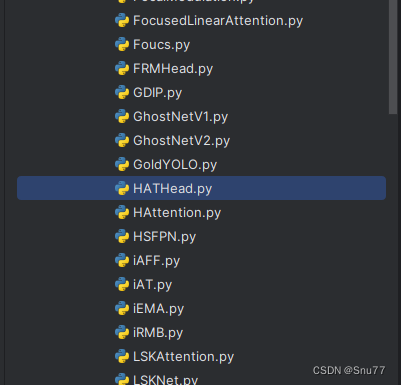
4.2 修改二
第二步我们在该目录下创建一个新的py文件名字为'__init__.py'(用群内的文件的话已经有了无需新建),然后在其内部导入我们的检测头如下图所示。
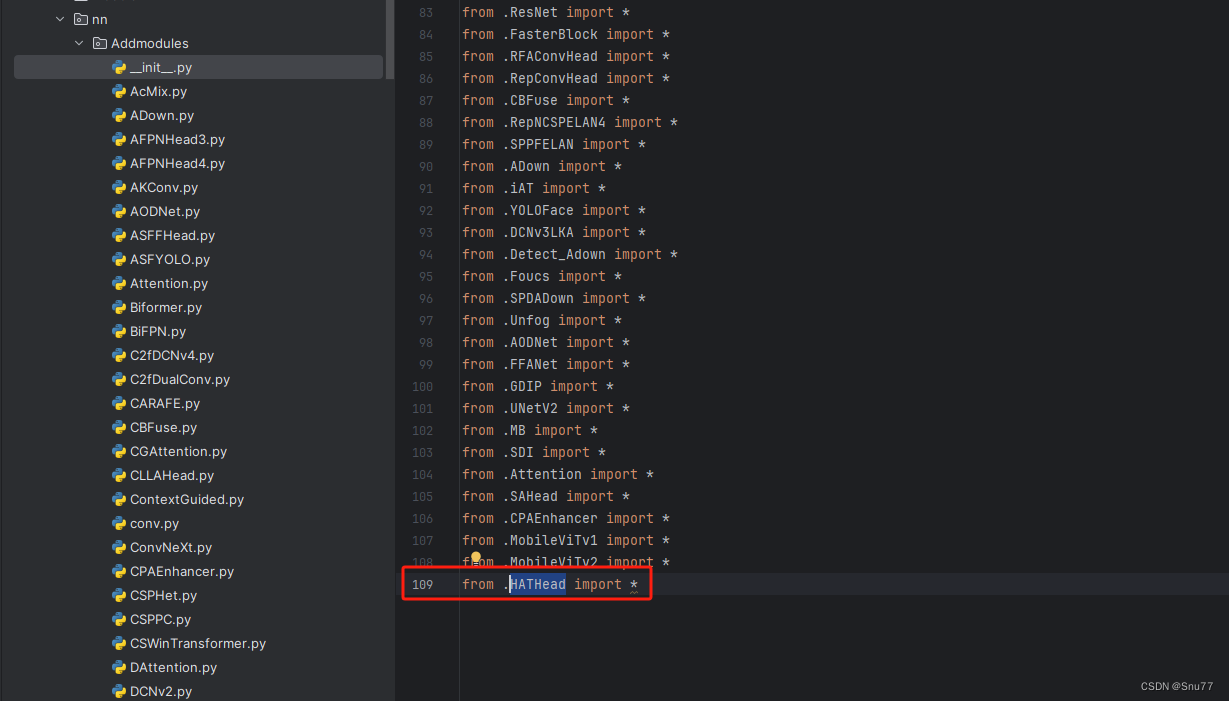
4.3 修改三
第三步我门中到如下文件'ultralytics/nn/tasks.py'进行导入和注册我们的模块(用群内的文件的话已经有了无需重新导入直接开始第四步即可)!
从今天开始以后的教程就都统一成这个样子了,因为我默认大家用了我群内的文件来进行修改!!
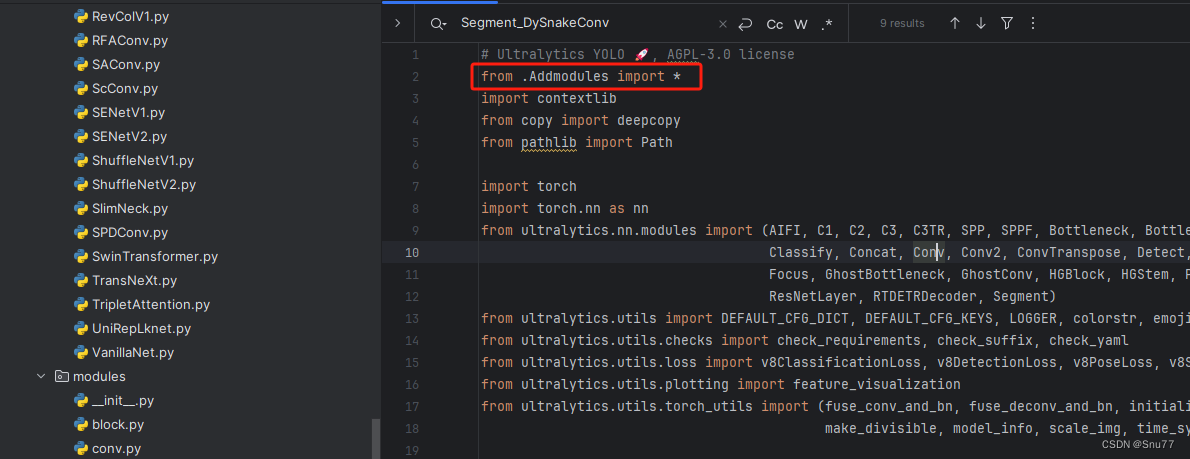
4.4 修改四
按照我的进行添加即可,当然其中有些检测头你们的文件中可能没有,无需理会,主要看其周围的代码一直来寻找即可!

4.5 修改五
按照我下面的添加!

4.6 修改六
注意!!!注意!!!
此处在YOLOv8.1版本之后以及删除了不用改了,但是如果你是老版本此处需要修改,所以如果你的是新版本就不用修改了,如果是老版本的就需要修改(因为群里文件是新版本的下面的图片中的红框标记的代码换成本文的HATHead即可)。
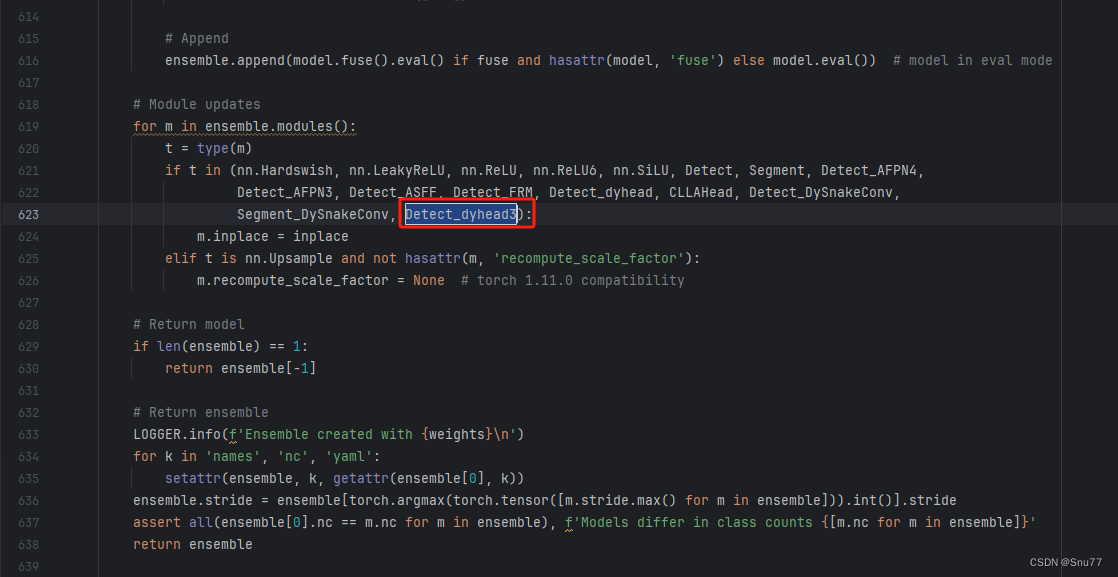
4.7 修改七
注意!!!注意!!!
此处在YOLOv8.1版本之后以及删除了不用改了,但是如果你是老版本此处需要修改,所以如果你的是新版本就不用修改了,如果是老版本的就需要修改(因为群里文件是新版本的下面的图片中的红框标记的代码换成本文的HATHead即可)。
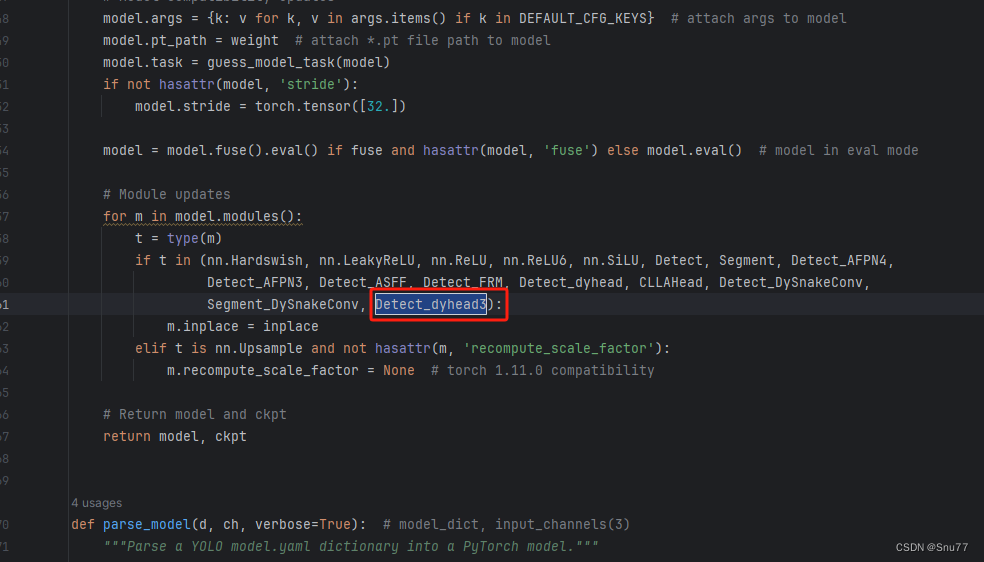
4.8 修改八
同理

4.9 修改九
这里有一些不一样,我们需要加一行代码
else:
return 'detect'为啥呢不一样,因为这里的m在代码执行过程中会将你的代码自动转换为小写,所以直接else方便一点,以后出现一些其它分割或者其它的教程的时候在提供其它的修改教程。

4.9 修改十
同理

五、 目标检测的yaml文件
5.1 yaml文件
复制如下的yaml文件即可运行。
# Ultralytics YOLO 🚀, AGPL-3.0 license
# YOLOv8 object detection model with P3-P5 outputs. For Usage examples see https://docs.ultralytics.com/tasks/detect
# Parameters
nc: 80 # number of classes
scales: # model compound scaling constants, i.e. 'model=yolov8n.yaml' will call yolov8.yaml with scale 'n'
# [depth, width, max_channels]
n: [0.33, 0.25, 1024] # YOLOv8n summary: 225 layers, 3157200 parameters, 3157184 gradients, 8.9 GFLOPs
s: [0.33, 0.50, 1024] # YOLOv8s summary: 225 layers, 11166560 parameters, 11166544 gradients, 28.8 GFLOPs
m: [0.67, 0.75, 768] # YOLOv8m summary: 295 layers, 25902640 parameters, 25902624 gradients, 79.3 GFLOPs
l: [1.00, 1.00, 512] # YOLOv8l summary: 365 layers, 43691520 parameters, 43691504 gradients, 165.7 GFLOPs
x: [1.00, 1.25, 512] # YOLOv8x summary: 365 layers, 68229648 parameters, 68229632 gradients, 258.5 GFLOP
# YOLOv8.0n backbone
backbone:
# [from, repeats, module, args]
- [-1, 1, Conv, [64, 3, 2]] # 0-P1/2
- [-1, 1, Conv, [128, 3, 2]] # 1-P2/4
- [-1, 3, C2f, [128, True]]
- [-1, 1, Conv, [256, 3, 2]] # 3-P3/8
- [-1, 6, C2f, [256, True]]
- [-1, 1, Conv, [512, 3, 2]] # 5-P4/16
- [-1, 6, C2f, [512, True]]
- [-1, 1, Conv, [1024, 3, 2]] # 7-P5/32
- [-1, 3, C2f, [1024, True]]
- [-1, 1, SPPF, [1024, 5]] # 9
# YOLOv8.0n head
head:
- [-1, 1, nn.Upsample, [None, 2, 'nearest']]
- [[-1, 6], 1, Concat, [1]] # cat backbone P4
- [-1, 3, C2f, [512]] # 12
- [-1, 1, nn.Upsample, [None, 2, 'nearest']]
- [[-1, 4], 1, Concat, [1]] # cat backbone P3
- [-1, 3, C2f, [256]] # 15 (P3/8-small)
- [-1, 1, Conv, [256, 3, 2]]
- [[-1, 12], 1, Concat, [1]] # cat head P4
- [-1, 3, C2f, [512]] # 18 (P4/16-medium)
- [-1, 1, Conv, [512, 3, 2]]
- [[-1, 9], 1, Concat, [1]] # cat head P5
- [-1, 3, C2f, [1024]] # 21 (P5/32-large)
- [[15, 18, 21], 1, HATHead, [nc]] # Detect(P3, P4, P5)
5.2 运行记录
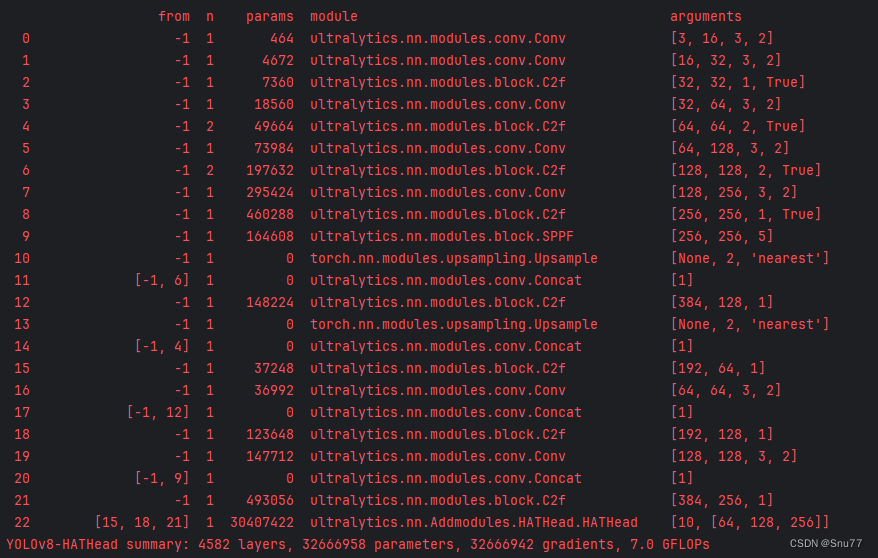
六、本文总结
到此本文的正式分享内容就结束了,在这里给大家推荐我的YOLOv8改进有效涨点专栏,本专栏目前为新开的平均质量分98分,后期我会根据各种最新的前沿顶会进行论文复现,也会对一些老的改进机制进行补充,如果大家觉得本文帮助到你了,订阅本专栏,关注后续更多的更新~
专栏回顾: